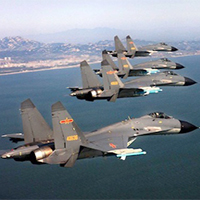China’s forces grow more sophisticated

China is improving its military doctrine, training, weapons and surveillance to be able to conduct more sophisticated attacks against the United States and other adversaries, including Japan, according to the Pentagon.
After jamming communications and mounting other forms of electronic and cyberwarfare, stealthy Chinese aircraft, drones and missiles could attack U.S. warships, aircraft and supply craft, the Defense Department said last week in its annual report on China.
The report, which is required by Congress, doesn’t suggest that such attacks are likely, only that the Chinese military last year continued to demonstrate new capabilities similar to those the U.S. began embracing at least 20 years ago, with mixed success. The buildup is occurring as China increasingly asserts itself in territorial disputes with its neighbors, including Japan, Washington’s top Asian ally.
“Although the Pentagon was overstating the Chinese military threat to avoid more cuts in its budget, the speed of the People’s Liberation Army’s modernization has indeed exceeded western countries’ expectation,” said Ni Lexiong, director of national defense policy research at Shanghai University of Political Science and Law.
“The gap is between 20 and 30 years,” he said. “At the current pace, China may catch up with the U.S. in 40 years, and may start to get ahead in 60 years,” he said.
China’s military buildup is appropriate and solely for defending its own sovereignty, Foreign Ministry spokesman Hong Lei said Friday at a briefing in Beijing. “We hope the U.S. gets rid of its biases, objectively and rationally regards China’s defensive capacity, and stops releasing these reports and makes concrete contribution to China and U.S. military cooperation,” he said.
China views the Pentagon’s annual report as a relic of the Cold War, when the U.S. prepared similar studies on the Soviet military threat, said Song Xiaojun, a Beijing-based military commentator for state-controlled CCTV.
Beijing’s anger is over “the fact that the U.S., whose military expenditure accounts for more than 4 percent of GDP and still runs the world’s biggest defense budget even with the proposed cutbacks, is accusing China of splashing out on the armed forces,” Song said in an interview. “In Beijing’s mind, it’s like you can eat five pieces of bread but not allow me to eat even half a piece.”
China is using its growing military muscle to aggressively assert its territorial claims in neighboring seas. In November, Beijing declared an air defense identification zone over a stretch of the East China Sea that overlaps with Japanese and South Korean airspace. China also is embroiled in disputes with Vietnam and the Philippines in the South China Sea that have led to maritime confrontations.
The Chinese Navy last year commissioned nine new Jiangdao-class corvettes armed with anti-ship cruise missiles for operations close to shore, “especially in the South China Sea and East China Sea,” the Pentagon said. The Pentagon’s test office and internal U.S. Navy reviews have warned that its new Littoral Combat Ships are vulnerable to such weapons.
The report may provide new fodder for U.S. congressional advocates of more defense spending who argue for improving naval capabilities to blunt Chinese advances through such systems as Boeing Co.’s EA-18G Growler electronic-warfare plane and Raytheon Co.’s new air and missile defense radar and next-generation jammer.
China “now has incredible economic clout and has become adept at applying pressure below the threshold that would trigger a strong military response from the U.S. or its allies,” said John Blaxland, a senior fellow at the Australian National University’s Strategic and Defence Studies Center, based in Canberra. “China may well be critical of this report but they’re probably secretly happy that that’s the perception.”
Last year, the Chinese military “emphasized training under realistic combat scenarios” and the ability to execute long-range mobility operations, such as maritime exercises that involved all three Chinese Navy fleets, the report found.
The report doesn’t add new details to the U.S. contention that China is increasing its cyberattacks on the Pentagon, instead repeating paragraphs it published last year about Beijing’s activities in 2012 in a section entitled “Cyber Activities Directed Against the U.S. Department of Defense.”
Read more http://www.japantimes.co.jp